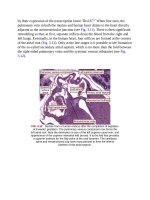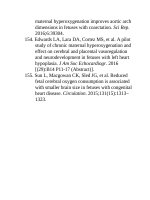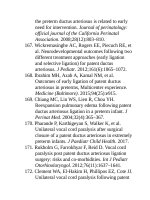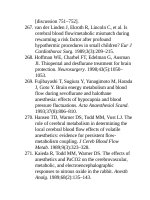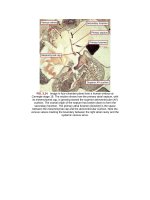Andersons pediatric cardiology 1844
Bạn đang xem bản rút gọn của tài liệu. Xem và tải ngay bản đầy đủ của tài liệu tại đây (115.44 KB, 3 trang )
DecisionMaking.
Inthepatientwithduct-dependentpulmonarybloodflow,creationofareliable
sourceofflowisgenerallyperformedwithinthefirstweekoflife.Classicallya
thoracotomyisperformedonthesideoppositearchdominanceandanePTFE
graftisusedtocreateashuntbetweentheinnominatearteryandtheipsilateral
proximalpulmonaryartery.Thisapproachresultsinaprimarymedian
sternotomyincisionforthenext-stageoperation,butthedisadvantageisthatthe
ductcannotbecontrolledorligatedatthecompletionoftheprocedure.Having
bothapatentarterialductandasystemic-to-pulmonaryarteryshuntresultsin
hypotensionandlow-velocityflowthroughthesyntheticshunt,which
predisposestoshuntthrombosis;however,thisdoesnotbecomeapparentuntil
theductbeginstoclose.Inthecurrenteraamediansternotomyincisionis
commonlyusedforshuntconstruction.Thereareseveraladvantagestoamedian
sternotomy.73Theductcanbeligatedafterconstructionoftheshuntandthe
adequacyoftheshuntcanthereforebedetermined.Theinnominatearteryand
theproximalbranchpulmonaryarteryaremoreeasilyaccessed.Ifnecessary,
cardiopulmonarybypasssupportcanbeusedforconstructionoftheshuntifthe
patientdoesnottoleratebranchpulmonaryarteryocclusion.Patcharterioplasty
isnecessaryforproximalbranchpulmonaryarterystenosisintheregionofduct
insertion.
SurgicalTechnique.
Thoracotomy:Thepatientisplacedinthelateraldecubituspositionanda
posterolateralthoracotomyincisionismadeonthesideoppositetheaorticarch
throughthefourthinterspace.Anincisionismadeinthemediastinalpleura
posteriortothesuperiorcavalvein,andthepulmonaryandinnominatearteries
areidentified.Lymphnodesalongthesideofthetracheaareresectedandthe
pulmonaryarteryisdissectedasfarmediallyaspossible.Theinnominateartery
isfullymobilized.Heparinisadministered,typically,100units/kg,andthe
innominatearteryisisolated.Alongitudinalincisionismadeintheinferior
surfaceoftheinnominateartery.A3.5-or4.0-mmgraftiscommonlyused.The
graftiscutinabeveledfashiontoaccommodatetheangleoftheinnominate
arteryandananastomosisisconstructedwithfinemonofilamentsuture.An
alternativeapproachistoperformtheproximalanastomosistothesubclavian
artery.Theuseofthesmallersubclavianarteryastheoriginoftheshuntwilladd
resistancetoshuntandallowsforlarger-calibergrafttobeused;itmayalsobe
usefulinthesmallerpatienttoaccommodateanormal-calibergraft.65Oncethe
proximalanastomosisiscomplete,thegraftiscuttotheappropriatelengthto
reachthepulmonaryartery.Theinnominatearteryisde-aired,flowisrestored,
andthegraftiscontrolledwithafinevascularclamp.Afterisolatingthe
pulmonaryartery,alongitudinalarteriotomyismadeinthepulmonaryarteryand
thedistalanastomosisisperformed.Clampsandsnaresareremovedfromthe
pulmonaryarteryandtheshuntisopened.Thereshouldbeadropinblood
pressurecorrespondingtoflowintheshuntwithanincreaseinpulmonaryartery
saturations.Prostaglandininfusionishalted.
Sternotomy:Thepatientisplacedinthesupinepositionandamedian
sternotomyincisionisperformed.Afterexposingtheheart,theinnominateartery
ismobilized.Theproximalipsilateralpulmonaryarteryislikewiseexposed.It
maybepossibletoencircletheductatthispoint,butcareshouldbetaken,as
thismaynotbetoleratedbecauseitcanresultinexcessivehypoxemia;in
addition,theductcanbebruisedorinjured,andthiswouldalsocompromise
pulmonarybloodflow.Theshuntisconstructedthesameasforathoracotomy
approach.Followingcompletionoftheshuntandafterithasbeenopened,the
ductcanbeencircledandsnaredtomakecertainthattherewillbeadequate
pulmonarybloodflowwiththenewlyconstructedshunt.Ifthesaturations
remainsatisfactory,theductisligated.Ifthepatientdevelopsexcessive
hypoxemiawithsnaringoftheduct,astepwiseapproachtodeterminethe
problemshouldbeundertaken,includingmakingcertainthatventilationis
adequate.Theshuntshouldfinallybeinspectedfortechnicalissues.Revisionof
theshuntorreplacementwithlargergraftshouldbeconsideredifocclusionof
theductisnottolerated.
UnobstructedSystemicandPulmonaryBlood
Flow
Withinitiationofspontaneousrespirationafterbirth,PVRbeginstodrop.For
patientswithafUVHandwithoutanatomiclimitationtopulmonaryorsystemic
bloodflow,heartfailurewillpredictablydevelopwiththedropinPVR.
DecisionMaking.
Pulmonaryarterybandingisthefirststageofpalliationinneonateswith
unrestrictivepulmonarybloodflowandnosystemicoutflowtractobstruction
(Fig.71.3).74Pulmonaryarterybandingrelievesthevolumeloadontheheart;
otherwiseheartfailuremayensue.Pulmonaryarterybandingreducespulmonary
arterypressure,allowingforcontinuedremodelingofthepulmonaryvascular
bedforsubsequentsecondstageofpalliation.NeonatalPVRreachesanadir
aroundthethirdorfourthweekoflife,andtraditionallypulmonaryarteryband
placementhasbeenperformedafter2or3weeksofage.Ithasbeenthoughtthat
placingapulmonaryarterybandintheearlyneonatalperiodmayleadtothe
needtoreoperateforbandreadjustmentoncethePVRfalls.75Recentdata,
however,suggestthatdelayisnotnecessary,andthatpulmonaryarterybanding
canbeperformedduringthefirstweekortwooflife.76
FIG.71.3 Constructionofapulmonaryarteryband(PAB).Ao,Aorta;PA,
pulmonaryartery.(FromTweddellJS.Principlesandpracticeofpediatric
surgery.In:OldhamKT,ColombaniPM,FogliaRP,etal,eds.Annalsof
Surgery.Philadelphia:LippincottWilliams&Wilkins;2006:1804.)
Ligationofthemainpulmonaryarteryandplacementofasystemic-topulmonaryarteryshunthasbeenadvocatedbysomeasastrategytomanagethe
patientwithunrestrictedpulmonarybloodflow.Thetheoreticaladvantageisthe
abilitytomorepreciselycontrolpulmonarybloodflow.Thisisuncommonly
usedinpracticeduetheincreasedriskofsystemic-to-pulmonaryarteryshunt
comparedwithpulmonaryarterybanding.
Pulmonaryarterybandingcanbeperformedthroughathoracotomyormedian
sternotomyincision.Ifthearterialductispatentorthereisanyquestionof
